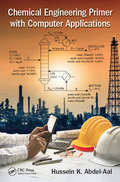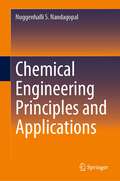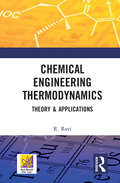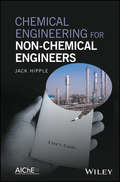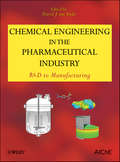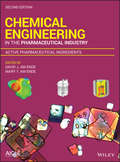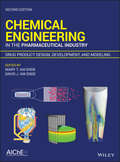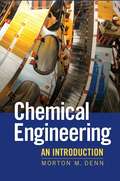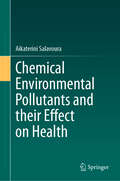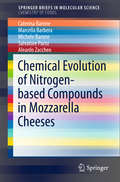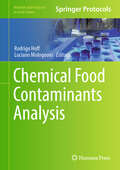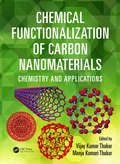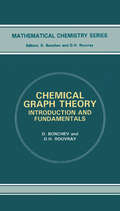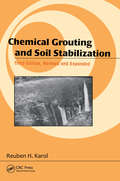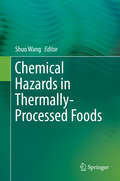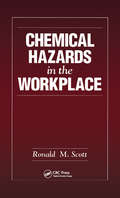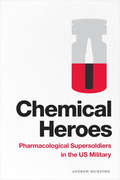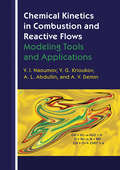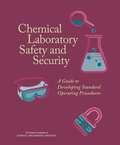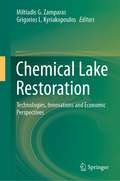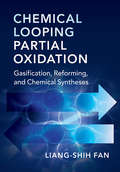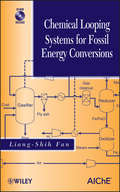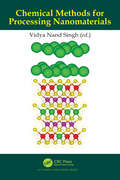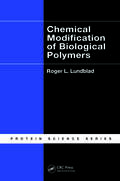- Table View
- List View
Chemical Engineering Primer with Computer Applications
by Hussein K. Abdel-AalTaking a highly pragmatic approach to presenting the principles and applications of chemical engineering, this companion text for students and working professionals offers an easily accessible guide to solving problems using computers. The primer covers the core concepts of chemical engineering, from conservation laws all the way up to chemical kinetics, without heavy stress on theory and is designed to accompany traditional larger core texts. The book presents the basic principles and techniques of chemical engineering processes and helps readers identify typical problems and how to solve them. Focus is on the use of systematic algorithms that employ numerical methods to solve different chemical engineering problems by describing and transforming the information. Problems are assigned for each chapter, ranging from simple to difficult, allowing readers to gradually build their skills and tackle a broad range of problems. MATLAB and Excel® are used to solve many examples and the more than 70 real examples throughout the book include computer or hand solutions, or in many cases both. The book also includes a variety of case studies to illustrate the concepts and a downloadable file containing fully worked solutions to the book’s problems on the publisher’s website. Introduces the reader to chemical engineering computation without the distractions caused by the contents found in many texts. Provides the principles underlying all of the major processes a chemical engineer may encounter as well as offers insight into their analysis, which is essential for design calculations. Shows how to solve chemical engineering problems using computers that require numerical methods using standard algorithms, such as MATLAB® and Excel®. Contains selective solved examples of many problems within the chemical process industry to demonstrate how to solve them using the techniques presented in the text. Includes a variety of case studies to illustrate the concepts and a downloadable file containing fully worked solutions to problems on the publisher’s website. Offers non-chemical engineers who are expected to work with chemical engineers on projects, scale-ups and process evaluations a solid understanding of basic concepts of chemical engineering analysis, design, and calculations.
Chemical Engineering Principles and Applications
by Nuggenhalli S. NandagopalThis text provides a clear and concise understanding of the principles and applications of chemical engineering using a rigorous, yet easy-to-follow, presentation. The coverage is broad, and it includes all the relevant concepts such as mass and energy balances, mass transfer, chemical reaction engineering, and many more. Elucidation of the principles is further reinforced by examples and practice problems with detailed solutions. Firmly grounded in the fundamentals, the book maximizes readers’ capacity to take on new problems and challenges in the field with confidence and conviction. Providing a ready reference and review of essential principles and their applications in chemical engineering, the book is ideal for undergraduate chemical engineering students, as well as practicing engineers preparing for the engineering license exams (FE and PE) in USA and abroad.
Chemical Engineering Thermodynamics: Theory & Applications
by R. RaviThe book presents concepts and equations of equilibrium thermodynamics or thermostatics. Key features that distinguish this book from others on chemical engineering thermodynamics are: a mathematical treatment of the developments leading to the discovery of the internal energy and entropy; a clear distinction between the classical thermodynamics of Carnot, Clausius and Kelvin and the thermostatics of Gibbs; an intensive/specific variable formalism from which the extensive variable formalism is obtained as a special case; a systematic method of obtaining the central equations of thermostatics with the use of the implicit/inverse function theorems and the chain rule. Please note: Taylor & Francis does not sell or distribute the Hardback in India, Pakistan, Nepal, Bhutan, Bangladesh and Sri Lanka.
Chemical Engineering for Non-Chemical Engineers
by Jack HippleOutlines the concepts of chemical engineering so that non-chemical engineers can interface with and understand basic chemical engineering concepts
Chemical Engineering in the Pharmaceutical Industry
by David J. am EndeThis book deals with various unique elements in the drug development process within chemical engineering science and pharmaceutical R&D. The book is intended to be used as a professional reference and potentially as a text book reference in pharmaceutical engineering and pharmaceutical sciences. Many of the experimental methods related to pharmaceutical process development are learned on the job. This book is intended to provide many of those important concepts that R&D Engineers and manufacturing Engineers should know and be familiar if they are going to be successful in the Pharmaceutical Industry. These include basic analytics for quantitation of reaction components- often skipped in ChE Reaction Engineering and kinetics books. In addition Chemical Engineering in the Pharmaceutical Industry introduces contemporary methods of data analysis for kinetic modeling and extends these concepts into Quality by Design strategies for regulatory filings. For the current professionals, in-silico process modeling tools that streamline experimental screening approaches is also new and presented here. Continuous flow processing, although mainstream for ChE, is unique in this context given the range of scales and the complex economics associated with transforming existing batch-plant capacity.The book will be split into four distinct yet related parts. These parts will address the fundamentals of analytical techniques for engineers, thermodynamic modeling, and finally provides an appendix with common engineering tools and examples of their applications.
Chemical Engineering in the Pharmaceutical Industry, Active Pharmaceutical Ingredients: R And D To Manufacturing
by David J. am Ende Mary T. am EndeA guide to the development and manufacturing of pharmaceutical products written for professionals in the industry, revised second edition The revised and updated second edition of Chemical Engineering in the Pharmaceutical Industry is a practical book that highlights chemistry and chemical engineering. The book’s regulatory quality strategies target the development and manufacturing of pharmaceutically active ingredients of pharmaceutical products. The expanded second edition contains revised content with many new case studies and additional example calculations that are of interest to chemical engineers. The 2nd Edition is divided into two separate books: 1) Active Pharmaceutical Ingredients (API’s) and 2) Drug Product Design, Development and Modeling. The active pharmaceutical ingredients book puts the focus on the chemistry, chemical engineering, and unit operations specific to development and manufacturing of the active ingredients of the pharmaceutical product. The drug substance operations section includes information on chemical reactions, mixing, distillations, extractions, crystallizations, filtration, drying, and wet and dry milling. In addition, the book includes many applications of process modeling and modern software tools that are geared toward batch-scale and continuous drug substance pharmaceutical operations. This updated second edition: • Contains 30new chapters or revised chapters specific to API, covering topics including: manufacturing quality by design, computational approaches, continuous manufacturing, crystallization and final form, process safety • Expanded topics of scale-up, continuous processing, applications of thermodynamics and thermodynamic modeling, filtration and drying • Presents updated and expanded example calculations • Includes contributions from noted experts in the field Written for pharmaceutical engineers, chemical engineers, undergraduate and graduate students, and professionals in the field of pharmaceutical sciences and manufacturing, the second edition of Chemical Engineering in the Pharmaceutical Industry focuses on the development and chemical engineering as well as operations specific to the design, formulation, and manufacture of drug substance and products.
Chemical Engineering in the Pharmaceutical Industry, Active Pharmaceutical Ingredients: R And D To Manufacturing
by David J. am Ende Mary T. am EndeA guide to the development and manufacturing of pharmaceutical products written for professionals in the industry, revised second edition The revised and updated second edition of Chemical Engineering in the Pharmaceutical Industry is a practical book that highlights chemistry and chemical engineering. The book’s regulatory quality strategies target the development and manufacturing of pharmaceutically active ingredients of pharmaceutical products. The expanded second edition contains revised content with many new case studies and additional example calculations that are of interest to chemical engineers. The 2nd Edition is divided into two separate books: 1) Active Pharmaceutical Ingredients (API’s) and 2) Drug Product Design, Development and Modeling. The active pharmaceutical ingredients book puts the focus on the chemistry, chemical engineering, and unit operations specific to development and manufacturing of the active ingredients of the pharmaceutical product. The drug substance operations section includes information on chemical reactions, mixing, distillations, extractions, crystallizations, filtration, drying, and wet and dry milling. In addition, the book includes many applications of process modeling and modern software tools that are geared toward batch-scale and continuous drug substance pharmaceutical operations. This updated second edition: • Contains 30new chapters or revised chapters specific to API, covering topics including: manufacturing quality by design, computational approaches, continuous manufacturing, crystallization and final form, process safety • Expanded topics of scale-up, continuous processing, applications of thermodynamics and thermodynamic modeling, filtration and drying • Presents updated and expanded example calculations • Includes contributions from noted experts in the field Written for pharmaceutical engineers, chemical engineers, undergraduate and graduate students, and professionals in the field of pharmaceutical sciences and manufacturing, the second edition of Chemical Engineering in the Pharmaceutical Industry focuses on the development and chemical engineering as well as operations specific to the design, formulation, and manufacture of drug substance and products.
Chemical Engineering in the Pharmaceutical Industry: Drug Product Design, Development, and Modeling
by David J. am Ende Mary T. am EndeA guide to the important chemical engineering concepts for the development of new drugs, revised second edition The revised and updated second edition of Chemical Engineering in the Pharmaceutical Industry offers a guide to the experimental and computational methods related to drug product design and development. The second edition has been greatly expanded and covers a range of topics related to formulation design and process development of drug products. The authors review basic analytics for quantitation of drug product quality attributes, such as potency, purity, content uniformity, and dissolution, that are addressed with consideration of the applied statistics, process analytical technology, and process control. The 2nd Edition is divided into two separate books: 1) Active Pharmaceutical Ingredients (API’s) and 2) Drug Product Design, Development and Modeling. The contributors explore technology transfer and scale-up of batch processes that are exemplified experimentally and computationally. Written for engineers working in the field, the book examines in-silico process modeling tools that streamline experimental screening approaches. In addition, the authors discuss the emerging field of continuous drug product manufacturing. This revised second edition: Contains 21 new or revised chapters, including chapters on quality by design, computational approaches for drug product modeling, process design with PAT and process control, engineering challenges and solutions Covers chemistry and engineering activities related to dosage form design, and process development, and scale-up Offers analytical methods and applied statistics that highlight drug product quality attributes as design features Presents updated and new example calculations and associated solutions Includes contributions from leading experts in the field Written for pharmaceutical engineers, chemical engineers, undergraduate and graduation students, and professionals in the field of pharmaceutical sciences and manufacturing, Chemical Engineering in the Pharmaceutical Industry, Second Edition contains information designed to be of use from the engineer's perspective and spans information from solid to semi-solid to lyophilized drug products.
Chemical Engineering: An Introduction
by Morton Denn'Chemical engineering is the field of applied science that employs physical, chemical, and biological rate processes for the betterment of humanity'. This opening sentence of Chapter 1 has been the underlying paradigm of chemical engineering. Chemical Engineering: A New Introduction is designed to enable the student to explore the activities in which a modern chemical engineer is involved by focusing on mass and energy balances in liquid-phase processes. Problems explored include the design of a feedback level controller, membrane separation, hemodialysis, optimal design of a process with chemical reaction and separation, washout in a bioreactor, kinetic and mass transfer limits in a two-phase reactor, and the use of the membrane reactor to overcome equilibrium limits on conversion. Mathematics is employed as a language at the most elementary level. Professor Morton M. Denn incorporates design meaningfully; the design and analysis problems are realistic in format and scope. Students using this text will appreciate why they need the courses that follow in the core curriculum.
Chemical Environmental Pollutants and their Effect on Health
by Aikaterini SalavouraThis book focuses on the impact of environmental chemicals on human health. Its coverage includes metals contaminating the environment, persistent organic pollutants (POPs), air pollution and endocrine disruptors. Harmful consumer products, workplace exposure, cosmetics, microplastic waste are described. Since most chemical substances are related to degenerative disorders and other communicable diseases, the proposed models of disease are analyzed, including cancer and psychiatry disorders. To provide an understanding of the mechanisms of diseases due to exposure, the book also covers basic background knowledge in genetics and epigenetic mechanisms. Oxidative stress and antioxidant mechanisms of the body are presented and how chronic inflammation and oxidative stress leads to disease. Finally, the role of a well-balanced diet and ingredients in the diet which prevent disease as well as the mechanisms of prevention are emphasized.
Chemical Evolution of Nitrogen-based Compounds in Mozzarella Cheeses (SpringerBriefs in Molecular Science)
by Salvatore Parisi Caterina Barone Aleardo Zaccheo Marcella Barbera Michele BaroneThis Brief evaluates the consequences of protein modifications in cheeses, with special emphasis on mozzarella cheeses. It explains the influence of biogenic amines on food quality and safety. As certain biogenic amines display a toxic potential to humans, considerable research has been undertaken in recent years to evaluate their presence in fermented foods, such as cheeses. This Brief summarizes how the presence of amines is influenced by different factors such as cheese variety, seasoning and microflora. The authors compare typical profiles of different products, e.g. ripe vs. unripe cheeses, focusing also on the different types of mozzarella cheeses. The Brief also introduces several analytical methods and simulation techniques, which are being used to evaluate the evolutive profiles of different selected molecules, protein aggregation, or proteolysis.
Chemical Food Contaminants Analysis (Methods and Protocols in Food Science)
by Rodrigo Hoff Luciano MolognoniThis volume provides protocols on different combinations of contaminates, matrices, and sample preparation. Chapters are divided into two parts, detailing polycyclic aromatic hydrocarbon,dioxins, furans, organochlorie pesticides, toxic elements, mycotoxins, mercury in food products, acrylamine, polypeptide antibiotics, tetracyclines, coccidiostats, beta-blockers, sedatives,glucocorticoids, palytoxin-like marine biotoxins in fish, polar drugs and contaminants in animal feed, UV filters, micro and nanoplastics in seafood, tetracyclines in vegetables, MCPDEs, and pharmaceuticals in seafood. Written in the format of the Methods and Protocols in Food Science (MeFS) series, the chapters include an introduction to the respective topic, list necessary materials and reagents, detail well-established and validated methods for readilyreproducible laboratory protocols, and contain notes on how to avoid or solve typical problems. Authoritative and cutting-edge,Chemical Food Contaminants Analysis aims to ensure successful results in the further study of this vital field
Chemical Functionalization of Carbon Nanomaterials: Chemistry and Applications
by Vijay Kumar Thakur Manju Kumari ThakurCarbon-based nanomaterials are rapidly emerging as one of the most fascinating materials in the twenty-first century. Chemical Functionalization of Carbon Nanomaterials: Chemistry and Applications provides a thorough examination of carbon nanomaterials, including their variants and how they can be chemically functionalized. It also gives a comprehe
Chemical Graph Theory: Introduction and Fundamentals (Mathematical Chemistry Ser.)
by D BonchevThis volume presents the fundamentals of graph theory and then goes on to discuss specific chemical applications. Chapter 1 provides a historical setting for the current upsurge of interest in chemical graph theory. Chapter 2 gives a full background of the basic ideas and mathematical formalism of graph theory and includes such chemically relevant notions as connectedness, graph matrix representations, metric properties, symmetry and operations on graphs. This is followed by a discussion on chemical nomenclature and the trends in its rationalization by using graph theory, which has important implications for the storage and retrieval of chemical information. This volume also contains a detailed discussion of the relevance of graph-theoretical polynomials; it describes methodologies for the enumeration of isomers, incorporating the classical Polya method, as well as more recent approaches.
Chemical Grouting And Soil Stabilization, Revised And Expanded
by Reuben H. KarolFollowing shifting trends from remedial to preventive uses of grouting practices, this third edition covers all aspects of chemical grouting methods and applications. This reference highlights new ground improvement techniques as well as recent innovations in soil modification and stabilization procedures. It considers commercial alternatives to ground improvement, their relative advantages and disadvantages, and the engineering applications to which these methods are suited. Revised and expanded, this new edition assesses the role of new grouting techniques in the containment of hazardous waste and introduces numerous problems to illustrate concepts and facilitate instruction.
Chemical Hazards in Thermally-Processed Foods
by Shuo WangThis book summarizes the types, contents, analytical methods, formation mechanisms and control strategies for hazardous substances produced during the thermal processing of foods. In each chapter, hazardous substances such as dicarbonyl compounds, acrylamide, furan, heterocyclic amines, trans-fatty acids, and advanced glycation end products (AGEs) are covered and discussed in terms of analytical methods, formation mechanisms and mitigation strategies.The content chiefly focuses on how these hazardous substances are formed during thermal processing and what can be done to mitigate or eliminate them in food products (e.g. those prepared at higher temperatures by baking, frying or roasting).The major objective of this book is to provide a timely and informative guide for researchers and graduate students in the fields of food chemistry, food ingredients, food analysis, food safety, food processing, chemical toxicology, disease prevention and health promotion.
Chemical Hazards in the Workplace
by Ronald M. ScottThis book introduces you to Industrial Toxicology - and is especially valuable for the engineer, scientists, or manager with responsibility - but no previous education or experience in the subject. Very "User Friendly." Text at the upper undergraduate and graduate level.
Chemical Heroes: Pharmacological Supersoldiers In The Us Military
by Andrew BickfordIn Chemical Heroes Andrew Bickford analyzes the US military's attempts to design performance enhancement technologies and create pharmacological "supersoldiers" capable of withstanding extreme trauma. <P><P>Bickford traces the deep history of efforts to biologically fortify and extend the health and lethal power of soldiers from the Cold War era into the twenty-first century, from early adoptions of mandatory immunizations to bio-protective gear, to the development and spread of new performance enhancing drugs during the global War on Terrorism. In his examination of government efforts to alter soldiers' bodies through new technologies, Bickford invites us to contemplate what constitutes heroism when armor becomes built in, wired in, and even edited into the molecular being of an American soldier. Lurking in the background and dark recesses of all US military enhancement research, Bickford demonstrates, is the desire to preserve US military and imperial power.
Chemical Kinetics in Combustion and Reactive Flows: Modeling Tools and Applications
by V. I. Naoumov V. G. Krioukov A. L. Abdullin A. V. DeminFollowing elucidation of the basics of thermodynamics and detailed explanation of chemical kinetics of reactive mixtures, readers are introduced to unique and effective mathematical tools for the modeling, simulation and analysis of chemical non-equilibrium phenomena in combustion and flows. The reactor approach is presented considering thermochemical reactors as the focal points. Novel equations of chemical kinetics compiling chemical thermodynamic and transport processes make reactor models universal and easily applicable to the simulation of combustion and flow in a variety of propulsion and energy generation units. Readers will find balanced coverage of both fundamental material on chemical kinetics and thermodynamics, and detailed description of mathematical models and algorithms, along with examples of their application. Researchers, practitioners, lecturers, and graduate students will all find this work valuable.
Chemical Laboratory Safety and Security: A Guide to Developing Standard Operating Procedures
by Engineering Medicine National Academies of SciencesThe U.S. Department of State charged the Academies with the task of producing a protocol for development of standard operating procedures (SOPs) that would serve as a complement to the Chemical Laboratory Safety and Security: A Guide to Prudent Chemical Management and be included with the other materials in the 2010 toolkit. To accomplish this task, a committee with experience and knowledge in good chemical safety and security practices in academic and industrial laboratories with awareness of international standards and regulations was formed. The hope is that this toolkit expansion product will enhance the use of the previous reference book and the accompanying toolkit, especially in developing countries where safety resources are scarce and experience of operators and end-users may be limited.
Chemical Lake Restoration: Technologies, Innovations and Economic Perspectives
by Miltiadis G. Zamparas Grigorios L. KyriakopoulosThis book aims to structure, in a complete and sequential way, the mainstream technical knowledge which is related to eutrophication control. The book considers the development of innovative technologies for phosphate removal, while supporting the restoration of currently degraded lakes and reservoir systems. In addition, this book contains key-aspects of future benchmark interests being specially framed under the ongoing development of a circular economy. In particular, the book will contribute to a better understanding of the problem of internal P-loads and P-sources disposition towards a more effective control of nutrients’ enrichment in lakes. The chemical routes and environmental fate of such lake nutrients will be viewed in the light of innovative technologies (engineering dimensions) and circular economy perspectives (economics dimensions). The main theme extends to an economic appreciation of environmental polluted aquifers. The book will appeal to an interdisciplinary audience, covering a wide spectrum of scientific fields, such as environment, physical chemistry, surface chemistry, interfacial phenomena, coastal engineering, bio-engineering, environmental policy makers, and economists.
Chemical Looping Partial Oxidation: Gasification, Reforming, And Chemical Syntheses (Cambridge Series in Chemical Engineering)
by Liang-Shih FanThis is the first comprehensive guide to the principles and techniques of chemical looping partial oxidation. <P><P>With authoritative explanations from a pioneer of the chemical looping process, you will: <P>• Gain a holistic overview of metal oxide reaction engineering, with coverage of ionic diffusion, nanostructure formation, morphological evolution, phase equilibrium, and recyclability properties of metal oxides during redox reactions • Learn about the gasification of solid fuels, the reforming of natural gas, and the catalytic conversion of methane to olefins • Understand the importance of reactor design and process integration in enabling metal oxide oxygen carriers to produce desired products • Discover other applications of catalytic metal oxides, including the production of maleic anhydride and solar energy conversions Aspen Plus® simulation software and results accompany the book online. <P>This is an invaluable reference for researchers and industry professionals in the fields of chemical, energy and environmental engineering, and students studying process design and optimization.<P> The first book to bring together all the important aspects of chemical looping partial oxidation, including metal oxide development, reactor design, and process systems analysis.<P> Written by one of the pioneers of chemical looping technology Accompanied online by Aspen Plus® simulation files and results.
Chemical Looping Systems for Fossil Energy Conversions
by Liang-Shih FanThis book presents the current carbonaceous fuel conversion technologies based on chemical looping concepts in the context of traditional or conventional technologies. The key features of the chemical looping processes, their ability to generate a sequestration-ready CO2 stream, are thoroughly discussed. Chapter 2 is devoted entirely to the performance of particles in chemical looping technology and covers the subjects of solid particle design, synthesis, properties, and reactive characteristics. The looping processes can be applied for combustion and/or gasification of carbon-based material such as coal, natural gas, petroleum coke, and biomass directly or indirectly for steam, syngas, hydrogen, chemicals, electricity, and liquid fuels production. Details of the energy conversion efficiency and the economics of these looping processes for combustion and gasification applications in contrast to those of the conventional processes are given in Chapters 3, 4, and 5.Finally, Chapter 6 presents additional chemical looping applications that are potentially beneficial, including those for H2 storage and onboard H2 production, CO2 capture in combustion flue gas, power generation using fuel cell, steam-methane reforming, tar sand digestion, and chemicals and liquid fuel production. A CD is appended to this book that contains the chemical looping simulation files and the simulation results based on the ASPEN Plus software for such reactors as gasifier, reducer, oxidizer and combustor, and for such processes as conventional gasification processes, Syngas Chemical Looping Process, Calcium Looping Process, and Carbonation-Calcination Reaction (CCR) Process. Note: CD-ROM/DVD and other supplementary materials are not included as part of eBook file.
Chemical Methods for Processing Nanomaterials
by Vidya Nand SinghThis book discusses the latest advancements in the processing of various types of nanomaterials. The main objective of the book is to provide the reader with a comprehensive review of the latest advances in synthesis as well as processing of almost all kinds of nanomaterials using various physical and chemical methods. The book includes chapters on Chemical Methods such as microemulsions, colloidal route, wet chemical method, chemical vapor deposition technique, sol-gel method, electrodeposition for growing different kinds of nanomaterials including Chalcogenides, Metal Oxide nanostructures, perovskite nanocrystals, nano structures on patterned electrode, Low Dimensional Carbon Nanomaterials and applications at Nanoscale.
Chemical Modification of Biological Polymers
by Roger L. LundbladExamining the chemical modification of biological polymers and the emerging applications of this technology, Chemical Modification of Biological Polymers reflects the change in emphasis in this subsection of biotechnology from the study of protein structure and function toward applications in therapeutics and diagnostics. HighlightsThe basic organi
